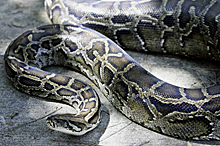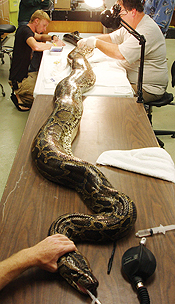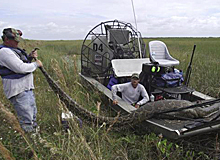Of all the invasions of non-native species altering ecosystems in the U.S., perhaps none has been more eye-popping than the proliferation of Burmese pythons across Florida’s Everglades.
Just three decades after the Southeast Asian species became established in southern Florida, experts believe there may now be tens of thousands of these giant snakes living across an 8,000-square-kilometer region and that these growing populations have dramatically reduced the numbers of once-common native species, including deer, bobcats and raccoons. Last month researchers euthanized the largest python ever found in the Everglades — a 17 ½-foot snake that was carrying 87 eggs, further evidence that this invasive species is well established in the region.

“You can go out and you can find pythons, but you can’t go out and find all the pythons — in any area,” Dorcas said. “They’re very secretive animals. And when you have a landscape that is very vast and inaccessible, it makes it very difficult to find these snakes.”
Yale Environment 360: Burmese pythons are native to Southeast Asia, yet they’re now pervasive across southern Florida. How did they get there?
Michael Dorcas: Well, that’s a good question. They’re in the United States because of the pet trade. Burmese pythons have been a major part of the reptile pet industry for decades. Everybody from little kids to adults buys Burmese pythons, often when they are very small. And when they get large oftentimes they want to get rid of them.
Now whether the snakes that are in the Everglades were released or whether they escaped, or both, nobody knows for sure.
e360: When did this start to become a problem?
Dorcas: Well, the research that we’ve done has shown that Burmese pythons have probably been a reproducing population in the Everglades at least since the 1980s. But it wasn’t until the year 2000, which is the year they were recognized as being established as a reproducing population, that the numbers started to increase dramatically and their geographic range started to increase substantially as well.
e360: How many do you think are out there now? And what kind of geographic range are we talking about?
Dorcas: It’s hard to know exactly where the front is, in terms of the invasion front, and how far north they’ve moved now. They’ve certainly moved south onto Key Largo. They’re certainly covering all of Everglades National Park, all of Big Cypress National Preserve, and are probably well north of Alligator Alley now.

e360: And they obviously get quite big. A team of researchers just recently found a python that was nearly 18 feet long.
Dorcas: I was actually down there at the time it was found. It was found in March but just recently it was euthanized. It was radio tracked from March until just recently. But, yes, it was 17 ½ feet long”¦ That’s the biggest one so far. A lot of pythons have been found have been 14 or 15 feet. A few have been around 16 feet.
e360: And this snake we’re talking about was carrying 87 eggs. Which suggests they’re getting comfortable in the region. They’re breeding quite successfully.
Dorcas: Yeah, they’ve clearly been breeding for quite some time, but that’s the biggest clutch [ever found]. Of course that’s because it’s the biggest female that’s been found. And so bigger females have more eggs.
e360: And according to your research — and anecdotal observations — they seem to be devouring a wide range of native species. Birds, mammals, even some alligators…
Dorcas: Primarily mammals and birds, with some alligators. But primarily they eat mammals and birds.
e360: In your recent research, you’ve looked specifically at the effects on mammal populations. What kind of species loss have you found? And how did you measure that?
Dorcas: We used the main park road in the southern part of Everglades National Park as a transect to sample mammals. And they were sampled that way before pythons proliferated back in the 1990s, before we realized
We’ve literally seen decreases of 99 percent of raccoons and possums.”they were even established. And then we’ve sampled them for many years since they’ve been established by simply driving the road and counting how many mammals we see, both dead and alive. And between the 1990s and the 2000s, we’ve literally seen decreases of 99 percent of raccoons and possums. We have not found a rabbit in the southern part of the Everglades since the year 2000 during our road transects. Bobcats are down 87 percent. Deer are down 94 percent.
So just across the board, mammals from numerous families, and even orders, have suffered severe declines that coincide both spatially and temporally with the proliferation of pythons in Everglades National Park.
e360: And these are species that were once abundant in the region?
Dorcas: Or once very common, yes. Back in the 1980s and ‘90s, they had raccoon control programs in Everglades National Park because they caused so many problems.
e360: How do you know these mammal declines are linked to growing python populations?
Dorcas: Well, we don’t know that for sure. But the data are consistent with that. And there has not been another hypothesis proposed that would cause those kinds of declines in such a diverse array of once-common mammals that really makes any sense. There’s no data to support any other hypotheses.
e360: It’s important to note that, historically, Burmese pythons are typically not a great threat to human beings, is that correct?

So large snakes can kill humans… They can probably kill an adult human, but probably could not swallow one.
e360: Even still, some of the prey species you’re talking about — deer, panthers, coyotes — they’re also large, fast, strong animals…
Dorcas: Exactly. We’re not nearly as fast or as strong. There was an 80-pound deer found in a python back in October of 2011.
e360: Can you describe how a python is able to catch an animal of that size? And then how do they kill them?
Dorcas: For the most part, pythons are ambush predators. They will sit in one place and wait for something to come by. This snake that was found with a deer inside of it was literally found right next to a deer trail. So probably this snake had been sitting there for a while waiting for a deer to come by, and then struck out and grabbed it, and wrapped around and constricted it, and then swallowed it.
e360: I suppose part of that is what sometimes occurs when a new species is introduced: The native species just aren’t used to them and are naïve to their threat.
Dorcas: Yes, that’s certainly a possibility and something that we discuss in our paper that was published in January.
e360: Does that seem to be part of the problem?
Dorcas: Well, we don’t know. There haven’t been any behavioral studies
You can go out and you can find pythons, but you can’t go out and find all the pythons — in any area.”of mammals in South Florida to look at how they respond to pythons. But it’s probably a safe assumption that things like raccoons and possums probably don’t associate snakes with being something that really is a major threat to them. Because there really hasn’t been a snake big enough to eat a raccoon living in Florida for about 18 million years.
e360: Is there any evidence that the Burmese python population explosion is having any other cascading effects on the ecosystem — whether it’s the plants and animals that were part of the diet of the species that are disappearing or the species that relied on them?
Dorcas: Not yet. Those have not been documented, but there are certainly a lot of questions about that that remain. For example, raccoons in most places are major nest predators of birds and reptiles. And if most of the raccoons are gone, then we might expect much higher nest survivorship in the Everglades ecosystem now. So it might be really beneficial for things like turtles.
e360: Are there any other exotic pets, non-native snakes or reptiles, that are having even remotely this type of impact on the Everglades?
Dorcas: Not necessarily on the Everglades, as far as we can tell. There are some that we’re really concerned about. There are lizards called tegus that are big lizards from South America that are common in the pet trade and are now established in South Florida and are major nest predators on turtles and birds and will also eat small animals. So those are a big concern. African pythons are now established just outside of Everglades National Park, and they’re very similar to Burmese pythons in terms of their size and their ecology. We don’t know how far they will spread. Boa constrictors are established in one area of Miami and have been there for at least a couple of decades as far as we can tell.

e360: What is it about the Everglades that has allowed the Burmese python to thrive so successfully?
Dorcas: Well, for one thing Miami is a kind of major reptile import-export hub in the U.S. The other thing, I’m sure the climate in South Florida is just conducive to a high diversity of animals, both native and non-native. It’s very conducive climate for animals to become established.
e360: Research has suggested that there’s a potential that their range could expand well beyond the Florida border. What’s the long-term range potential?
Dorcas: All of the valid climate models that have been produced actually show that at least all of the state of Florida and parts of the coastal plain of the Carolinas and so forth can be suitable climate for this species.
e360: You’ve studied their survivability in South Carolina… What did you find?
Dorcas: Yes, we did a study back in 2009, 2010, where we took 10 male snakes in the Everglades and we put them in a semi-natural enclosure outside in South Carolina, in the upper coastal plain. And many of the snakes survived well into the winter when it got really, really cold. But we had in 2009-2010 a record cold spell — or several prolonged record cold spells — and all the snakes ended up dying. The last ones died during the very last cold spell. So it remains to be seen whether that was realistic enough of an experiment.
e360: Do you think it’s too early, or hyperbolic, to consider that it is possible that their potential long-term range could include as much of a third of the United States, as some have suggested?
Dorcas: I think it’s too early to say that for sure. But I certainly think that it’s something that’s worth considering.
e360: And, of course, the question now is what do you do about them. Some people say you should kill them all. Others suggest they’re here to stay, and that we should just focus on limiting their expansion. What solutions do you think should be on the table?
MORE FROM YALE e360
Alien Species Reconsidered: Finding a Value in Non-Natives

You could possibly suppress their numbers in certain areas, and possibly prevent their spread if you hit them really hard in certain places. But if you’re relying on a technique to get rid of pythons that relies on you finding individual snakes, it’s going to be an extremely difficult task, if not impossible, to even suppress their populations.
e360: Earlier this year, [the] U.S. Fish and Wildlife [Service] introduced a ban on importing four exotic snakes — including the Burmese python. To what extent can that help, or is the problem too far along in the Everglades?
Dorcas: In terms of actual Burmese pythons, the only thing that’s really going to help is probably [preventing] them [from] becoming established potentially in other places. It might help in that regard in that people wouldn’t let them go in other parts of Florida, and even other states, because the trade in those animals would be reduced. So in terms of that species, that’s probably the most important thing. But if there are additional Burmese pythons released into South Florida, where they’re already established, it’s probably not going to make that big a difference.